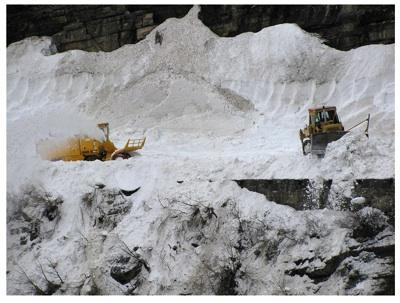When you look at the difficulties crews at Glacier National Park have each year opening the Going-to-the-Sun Road for summer traveler, you really have to appreciate the skills and tenacity of the men who built the road back in the 1920s and 1930s.
The latest effort to open the 50-mile road across Glacier has been dealt some setbacks by avalanches and heavy snows. According to a park press release, "Over the last week, more than two-and-a-half-feet of snow fell in the starting zones of avalanche paths along the Sun Road. In order to access their work site, crews re-plowed the slide paths where they encountered debris piles up to 10 feet deep."
As of Friday morning, plows on the west side of the Continental Divide had completed initial plowing through Haystack Creek and were continuing towards the Alps, three-and-a-half miles beyond the Loop. On the east side, crews had completed initial plowing through Siyeh Bend and were continuing to No Stump Point, approximately one mile beyond Siyeh Bend, according to the release.
Not only do the avalanches often push the plowing progress backwards, but they can be deadly, as well. In 1953 two men were killed when slides came down as they were working on opening the road, and another man was buried for eight hours -- and survived -- according to Man in Glacier, a book written by Curt Buckhholtz in 1976 that examines the impacts of humans on the park's landscape.
Avalanche danger persists throughout the park, park officials said Friday. Avalanches along the Sun Road in the spring can occur during and after snow storms, during and after rain events, and especially during sunny, warm days, they added in a release. During high avalanche danger, park officials do not advise hiker/biker travel on the Sun Road in the avalanche prone areas. Stopping in avalanche paths is not recommended.
Along with the avalanche danger, the spring runoff is expected to create dangerous conditions for hikers along streams, rivers and creek.
"Visitors are reminded to use caution around water. Visitors should be aware of their surroundings, the weather forecast, and not attempt to cross flooded roads as the road surface may be compromised," a park release said. "Swift and cold waterways, moss or lichen covered logs or rocks, undercut banks all present dangers."




Comments
All of us who enjoy our parks need to be sure that on every visit we thank those hardy folks who wear maintenance division uniforms. Thank them for keeping the parks safe and healthy for all of us.